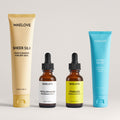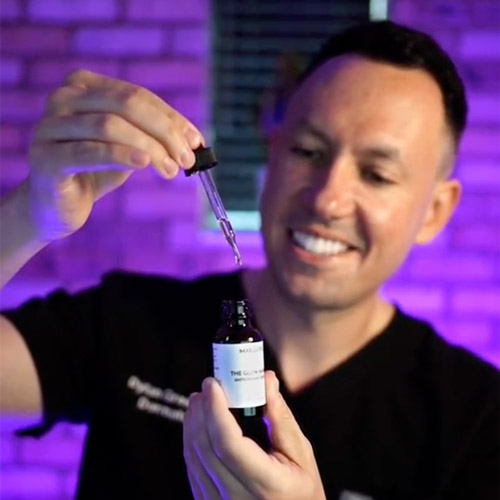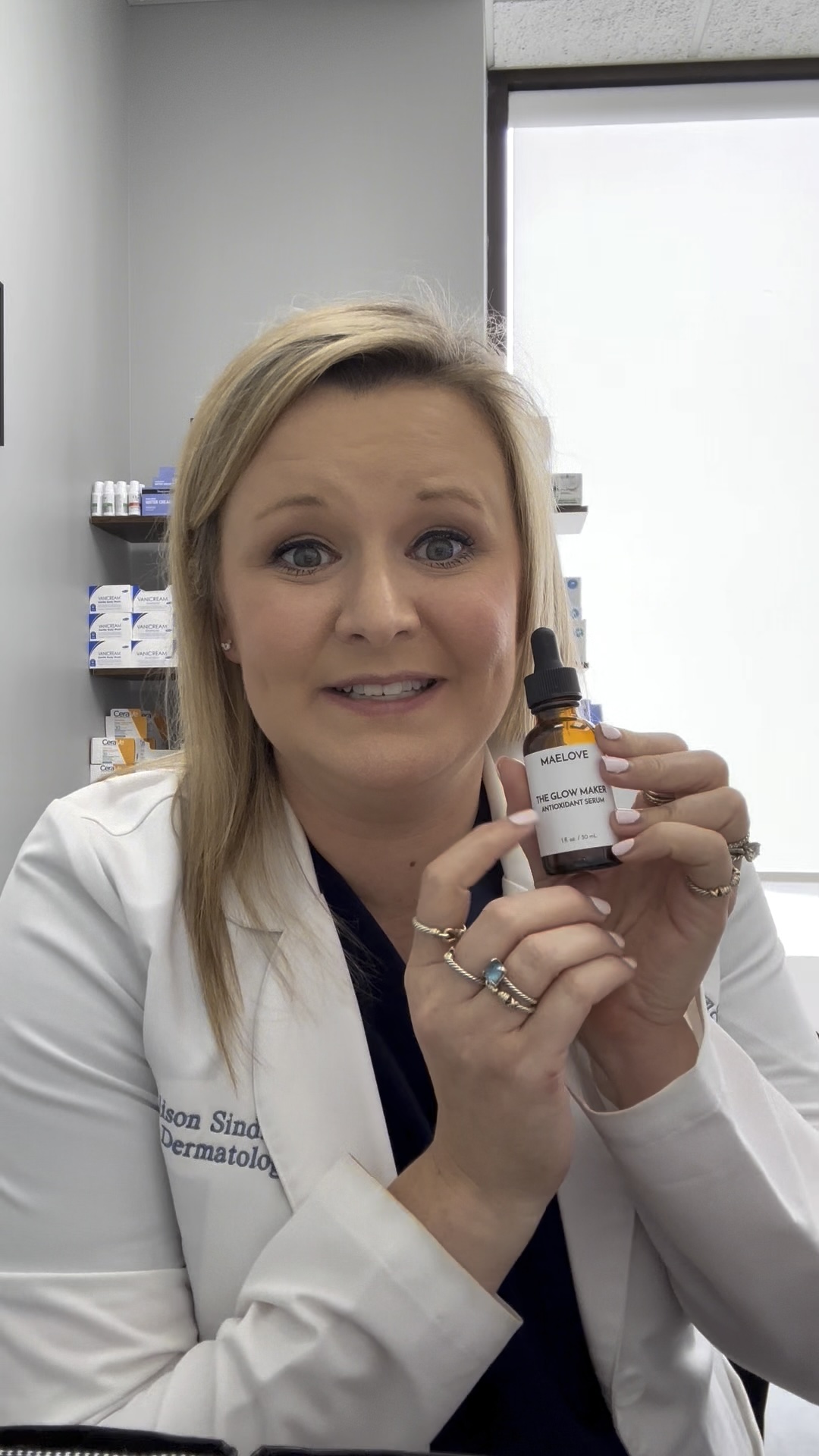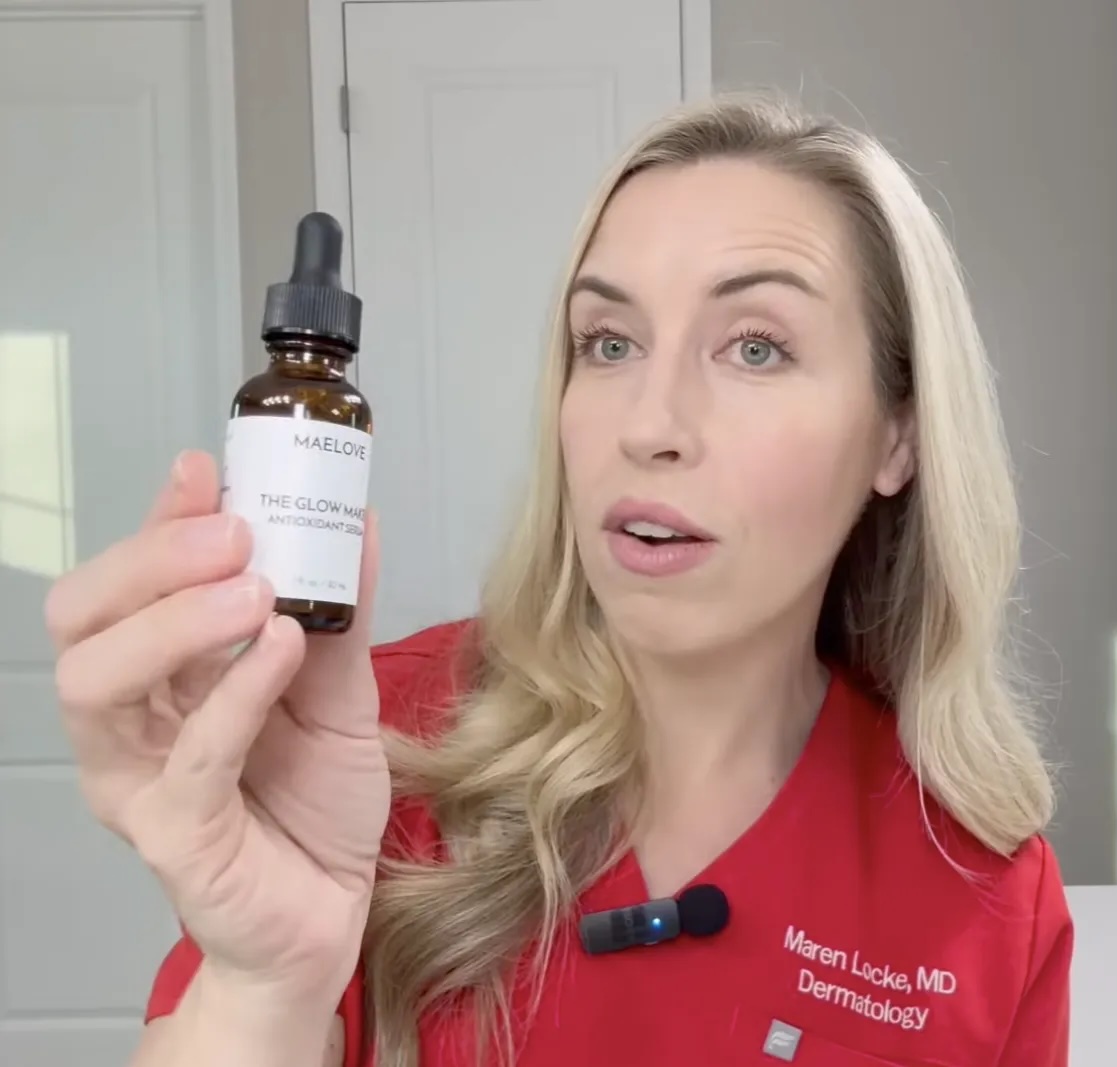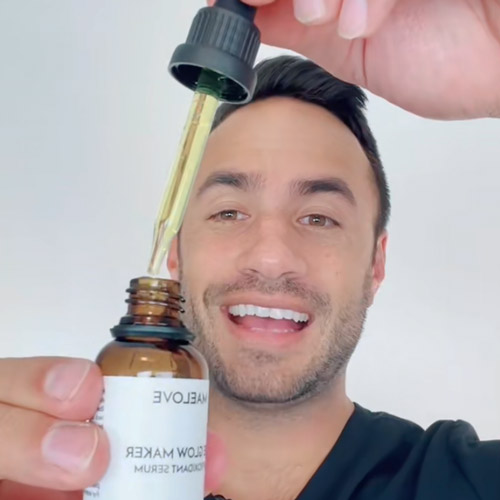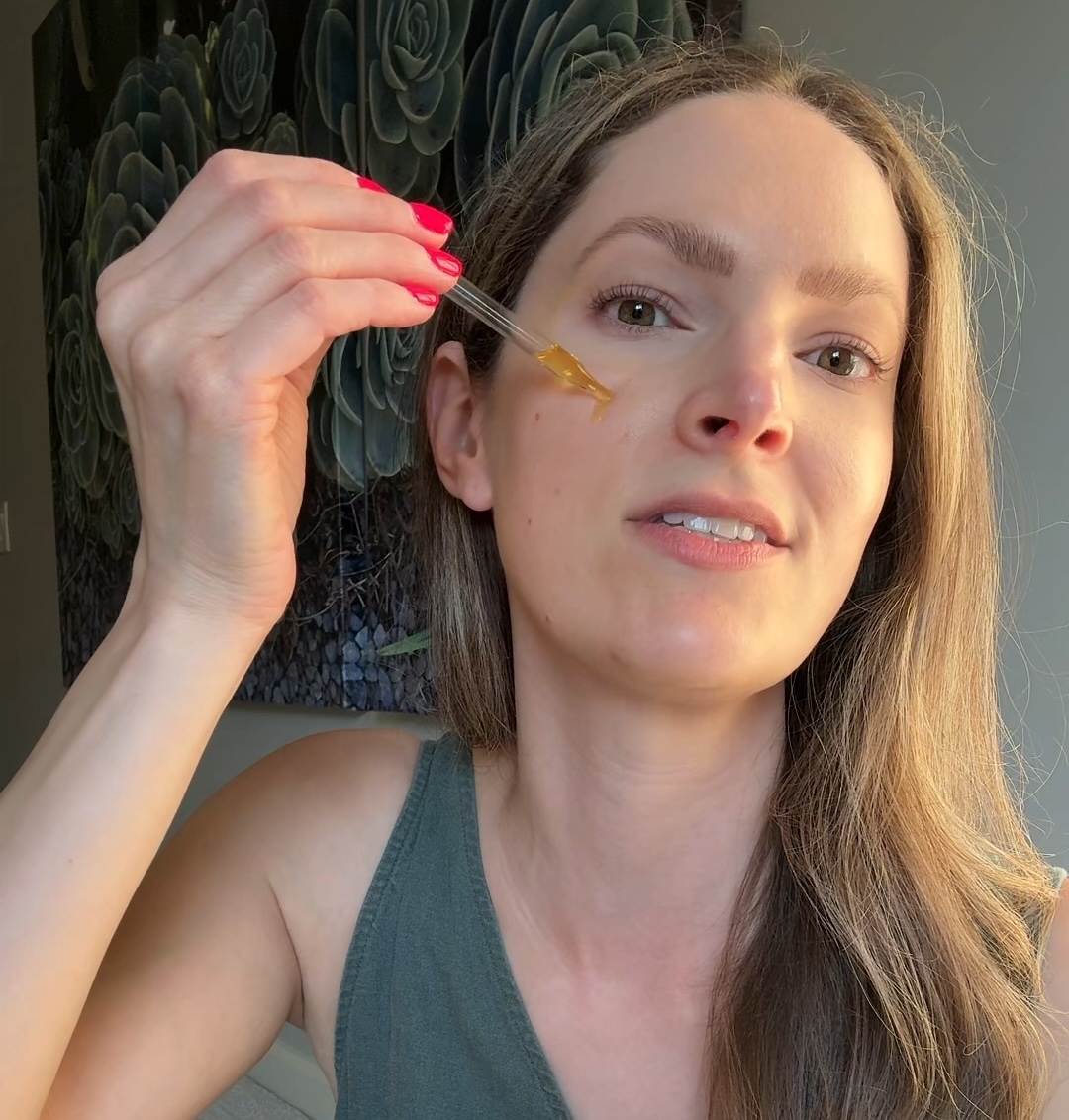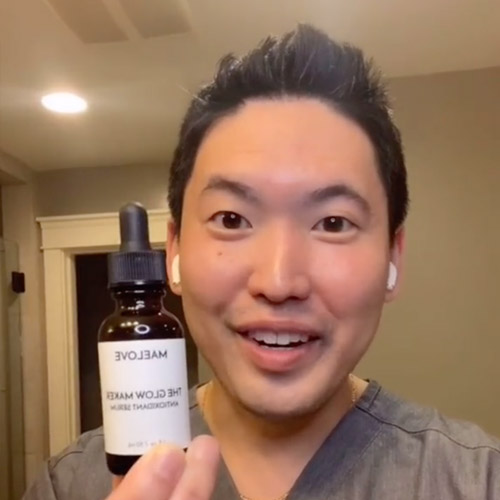

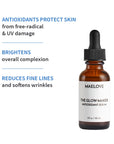
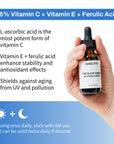

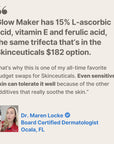
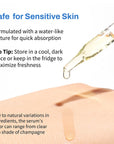
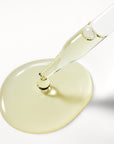
Our best selling serum 8 years running
Glow Maker Vitamin C Serum
Our extra-strength Vitamin C serum is the industry gold-standard, fortified with 15% L-Ascorbic Acid, Vitamin E, and Ferulic Acid to visibly brighten and firm. We designed this superior formula to be non-irritating for sensitive skin and water-like, non-sticky on the face. It delivers maximum potency and protection, refined for daily comfort.
We (and our customers) believe Glow Maker doesn’t just match the famous incumbent. It’s better.
We took the gold-standard formulation of 15% l-ascorbic acid, vitamin E and ferulic acid then improved on it in 3 key ways:
1. More sensitive skin friendly
By adding soothing ingredients to balance out the potency.
2. Less sticky
Almost water-like texture that doesn’t leave behind filmy residue.
3. Less smelly
Okay, we’ll admit this isn’t the best smelling serum in the world. But it doesn’t have that intensely dreaded “hot dog” water smell and we achieved it without using fragrances.
You get these 3 key improvements while also saving almost $150 a bottle compared to the famous incumbent. Want more details? Scroll lower to the page and visit our FAQ section.
Because Glow Maker has very light texture and absorbs very quickly, we recommend applying it as the first treatment right after washing your face.
Most brands would tell you to use vitamin C serum in the morning, and that’s a good advice (because vitamin C increases your skin’s protection from free-radials generated from UV exposure).
We think it’s even better to use vitamin C serum both morning and night because free radicals are attacking your skin 24 hours a day (free radicals break down your skin from inside and lead to hyperpigmentation and premature lines).
Plus, good vitamin C serums don’t last very long (vitamin C will not only neutralize free radicals in your skin but also in the air) so it’s better to indulge and use up quickly rather than rationing it and trying to keep it around longer.
Here is how a customer Tina D. uses Glow Maker:
“I always apply this serum in the morning right after cleansing and follow with the peptide serum. I also usually use it again at night because it absorbs easily it doesn’t feel like extra work and I think I can feel difference in the morning when I use it at night.”
BTW, the peptide serum Tina refers to is our Peptide Squad collagen renewal serum, which complements Glow Maker very well.
We ship from our FDA-registered, food-quality warehouse in Northern California five days a week (Mon–Fri). On most days, we’ll process and ship with your order within two business days, and you’ll get an email with tracking information when we process your order.
Enjoy free shipping on orders over $45 USD. Less than that there is $9.95 flat shipping charge.
Your purchase is protected by our 100-day free returns guarantee. You have full 100 days from when you receive your order to start your return. You can create a free shipping return label on our self-serve portal (you just need your order number and shipping zip code) or by e-mailing us at team@maelove.com
Introducing
The Glow Maker
OBSESSIVELY FORMULATED
The Glow Maker uses an expertly stabilized antioxidant blend of 15% L-ascorbic acid (the most effective form of vitamin C), vitamin E, and ferulic acid.
This proven trifecta reduces fine lines, evens out skin tone, and enhances the skin’s radiance by defending against UV and environmental damage.
Formulated with a water-like texture for quick absorption and a soothing blend of hyaluronic acid, aloe, vitis vinifera, and magnolia for extra nourishment. Make Glow Maker part of your daily routine for brighter, youthful skin.
WHY TOP DERMATOLOGISTS LOVE IT
Protects against premature aging and evens out skin tone
- Formulated with a powerhouse trio of 15% L-ascorbic acid, vitamin E, and ferulic acid
- Shields against premature aging caused by UV rays and environmental pollutants
- Diminishes hyperpigmentation, revealing a more even skin tone
Helps stimulate collagen production to help fight wrinkles
- Scientifically-backed vitamin C stimulates collagen production for firm, resilient skin
- Clinically-proven antioxidant blend visibly reduces the formation of fine lines and wrinkles
- Quick-absorbing formula allows for easy application under sunscreen and makeup
Use every morning for optimum protection throughout the day. Can be used twice daily (AM and PM) if desired. After cleansing, apply a thin layer of serum to the face, neck, and chest. Massage product in until it is fully absorbed.
Layer your products from thinnest to thickest in texture, waiting a full minute between each product. Follow with a gentle moisturizer to lock in the serums underneath.
The color, scent, and texture of each production batch can vary slightly depending on the batch of ferulic acid and natural extracts used, due to natural variations in these ingredients.
Once opened, we recommend that the serum be used up within 2-3 months and keep it in a cool, dark place in order to maximize freshness. You can store both open and unopened bottles in the fridge to help further maintain freshness. If you’re purchasing a backup bottle, please store in a refrigerator until you start using. We don't recommend having more than 1 backup bottle of Glow Maker at a time, as vitamin C is very delicate.
See our How to Layer guide for tips on layering multiple Maelove products.
Antioxidant Trio (15% L-AA + Vitamin E + Ferulic Acid)
- The gold-standard antioxidant blend
- Shields skin from daily environmental damage, visibly brightens tone, and supports firm, resilient skin
Hydration Support (Hyaluronic Acid)
- Keeps skin comfortable and hydrated
Calming Complex (Aloe + Vitis Vinifera (grape extract) + Magnolia Extracts)
- Botanical extracts that soothe the skin
- Ensures you receive high-potency results without the stinging or redness typical of other Vitamin C serums
Glow Maker is an oil-free formula. All Maelove products are: safe for sensitive skin, made in the US, vegan, cruelty-free, non-comedogenic, gluten-free, and free of parabens, phthalates, dyes, and artificial fragrances. We don't use ingredients that are banned in the EU or in the USA.
Show all ingredients
Customer Reviews
For the Curious
L-Ascorbic Acid, also known as Vitamin C, is one of nature’s best antioxidants and indeed, one of the primary defenses against UV damage employed by the skin. Special receptors in the skin pull Vitamin C out of your bloodstream to pack your skin full of this protective antioxidant which is also the most plentiful antioxidant in the skin (Pullar et al. 2017). The number one cause of premature aging of the skin is UV damage from the sun’s rays. When your skin is exposed to UV rays, free radicals are spawned. These free radicals are like ricocheting bullets tearing up collagen and even DNA leading to photoaged skin and skin cancers. Fine lines and wrinkles, sunspots, ruptured blood vessels, enlarged pores, and rough coarse skin are some of the features of photoaged skin.
While Vitamin C in your skin plays a crucial role, unfortunately, like so many processes that occur with general aging, the Vitamin C content in your skin wanes as you age irrespective of diet, as poor blood flow and nutrient delivery start to affect levels. In other words, your natural defenses against UV damage go down with aging. This is where topical supplementation can remedy the situation as the skin absorbs the Vitamin C applied at the skin’s surface (Pullar et al. 2017).
Scientific studies show that the skin will absorb (L-Ascorbic Acid) optimally from a serum when the concentration is between 10-20% Ascorbic Acid. At these concentrations, it reaches saturation after 3 days of consistent daily application (Pinnel et al. 2001). Other derivatives of Vitamin C may be used in Vitamin C serums but in this case, they must be converted into L-Ascorbic Acid inside your skin in order to have positive effects and studies do not necessarily show that this conversion occurs. L-Ascorbic Acid is the form of Vitamin C that has been scientifically studied and clinically proven.
As Vitamin C can be unstable in solution, combining with Vitamin E has been found to extend the stability of Vitamin C, as well as increase its effectiveness by four-fold (Lin et al. 2003). This is because Vitamin E as an antioxidant naturally works with Vitamin C in the skin to protect it. Vitamin C is hydrophilic (water loving) while Vitamin E is lipophilic (oil loving), and together, they can protect the watery and fatty elements in a cell. In fact, Vitamins C and E in isolation are minimally effective. Further, Vitamin C can regenerate oxidized Vitamin E. Ferulic acid is a plant antioxidant that combined with Vitamin E can further extend the effectiveness of Vitamins C by eight-fold (Lin et al. 2005). For these reasons, The Glow Maker is formulated with 15% Ascorbic Acid, Vitamin E and Ferulic Acid.
We recommend using both Glow Maker serum and sunscreen. A good broad-spectrum SPF is one of the most important things you can do to prevent photoaged skin. However, even good sunscreens only block about half of the free radicals spawned from UV exposure. Antioxidant Vitamin C serums help neutralize free radicals to protect your skin from harmful UV rays.
As Vitamin C in the skin is quickly depleted by fighting UV damage or other free radical generating activities such as smoke and pollution throughout the day, topical Vitamin C application twice a day may be useful to replenish levels when engaged in outdoors activities. Topical Vitamin C and sunscreen work by differing mechanisms to protect your skin so the combination is ideal (Lin et al. 2005, Telang et al. 2013).
Vitamin C is necessary in collagen production and topical Vitamin C has been scientifically proven to boost collagen production in aged skin (Nusgens et al. 2001). The collagen content in skin decreases over time – roughly 1% per year with accelerated loss post-menopause – leading to wrinkles and sagging as we get older. UV damage accelerates this process in photoaged skin.
The ability of topical Vitamin C to boost collagen production has been demonstrated in placebo-controlled trials of aged skin in postmenopausal women (Nusgens et al. 2001) and in those with photoaged skin (Traikovitch 1999). Note that the role of Vitamin C in collagen production is also responsible for its beneficial role in wound healing and for the skin symptoms of scurvy which results from Vitamin C deficiency (Pullar et al. 2017).
Another benefit of Vitamin C is that it can brighten and even out your skin tone by treating hyperpigmentation. This is not only because Vitamin C can fight UV damage which is a main cause of hyperpigmentation, but also because it can inhibit an enzyme (tyrosinase) involved in skin pigment production. A concentration of at least 10% Ascorbic acid is recommended to get maximal benefits against UV induced hyperpigmentation (DeDormeal et al. 2019).
Vitamin C serums must be acidic (pH < 3.5) in order to absorb into the skin and work (Pinnel et al. 2001). This is due to the fact that at a lower pH, Ascorbic Acid remains in its protonated form which is uncharged improving its ability to pass through the lipid-rich skin barrier.
For this reason, Vitamin C serums can be irritating. To help the situation, the Glow Maker is also formulated along with hydrating and skin soothing ingredients such as hyaluronic acid and a proprietary botanical blend of Vitis Vinifera, Aloe, Aurantium Dulcis and Magnolia. Further, so that it can be the first serum applied to clean skin to help in the absorption, Glow Maker is formulated to go on the skin thinly and absorb quickly so that it can be layered under other serums, moisturizers, and makeup. If your skin is too sensitive for acidic serums like The Glow Maker, we suggest the NIA 10 10% Niacinamide serum which can help soothe redness and irritation and build up the skin barrier.
Yes. Vitamin C is rated Category A in pregnancy by the FDA which means Vitamin C has been evaluated by clinical trials in pregnant women and deemed safe. The actives including Vitamin E, Ferulic Acid, and Hyaluronic Acid are all considered generally safe to use topically during pregnancy and lactation. However, it is always advisable to check with your doctor regarding skin care products and ingredients.
Due to the nature of vitamin C, it is normal for your serum to change colors over time. The initial color of each production batch can vary slightly depending on the batch of ferulic acid and natural extracts used, due to natural shade variations in these ingredients.
Even if your serum turns yellow, we've infused our serum with ingredients like ferulic and metabisulfite that help stabilize the vitamin C, so you're in good hands. It is time to toss and replace your Glow Maker when it starts to turn a brown color. Most bottles are good for 3-6 months after opening.
One tip to help keep your serum at its freshest is to squeeze and hold the dropper top while you close the bottle to eliminate excess air. Storing the bottle in the fridge also keeps the serum at its freshest.
Pinnell SR, Yang H, Omar M, Monteiro Riviere N, De Buys HV, Walker LC, Yang Y, Levine M (2001). “Topical L-Ascorbic Acid: Percutaneous Absorption Studies.” Dermatol Surg 27:137-142.
Pullar JM, Carr AC, Vissers MCM (2017). “The Roles of Vitamin C in Skin Health.” Nutrients. 9:866. doi:10.3390/nu9080866
Lin JY, Selim MA, Shea CR, Grichnik JM, Omar MM, Monteiro-Riviere NA, Pinnell SR (2003). “UV photoprotection by combination topical antioxidants, vitamin C and vitamin E.” J Amer Acad Dermatol. 48:866-874
Lin FH, Lin JY, Gupta RD, Tournas JA, Burch JA, Selim MA, Monteiro-Riviere NA, Grichik JM, Zielinski J, Pinnell SR (2005). “Ferulic Acid Stabilizes a Solution of Vitamins C and E and Doubles its Photoprotection of Skin.” J Invest Dermatol 125:826-832
Lin FH, Lin JY, Gupta RD, Tournas JA, Burch JA, Selim MA, Monteiro-Riviere NA, Grichik JM, Zielinski J, Pinnell SR (2005). “Ferulic Acid Stabilizes a Solution of Vitamins C and E and Doubles its Photoprotection of Skin.” J Invest Dermatol 125:826-832
Telang PS (2013). “Vitamin C in Dermatology.” Indian Dermatol Online J. 4(2): 143-146.
Nusgens BV, Humbert P, Rougier A, Colige AC, Haftek M, Lambert CA, Richard A, Creidi P, Lapiere CM (2001). “Topically Applied Vitamin C Enhances them RNA Level of Collagens I and III, Their Processing Enzymes and Tissue Inhibitor of Matrix Metalloproteinase 1 in the Human Dermis.” J Investig Dermatol 116(6): 853-859.
Pullar JM, Carr AC, Vissers MCM (2017). “The Roles of Vitamin C in Skin Health.” Nutrients. 9:866. doi:10.3390/nu9080866.
Traikovich SS (1999). “Use of Topical Ascorbic Acid and Its Effects on Photodamaged Skin Topography.” Arch Otolaryngol Head Neck Surg 125:1091-1098.
DeDormael R, Bastien P, Sextus P, Gueniche A, Ye D, Tran C, Chevalier V, Gomes C, Souverain L, Tricaud C (2019). “Vitamin C Prevents Ultraviolet-induced Pigmentation in Healthy Volunteers: Bayesian Meta-analysis Results from 31 Randomized Controlled versus Vehicle Clinical Studies.” J Clin Aesthet Dermatol. 12(2): E53-E59
Pinnell SR, Yang H, Omar M, Monteiro Riviere N, De Buys HV, Walker LC, Yang Y, Levine M (2001). “Topical L-Ascorbic Acid: Percutaneous Absorption Studies.” Dermatol Surg 27:137-142.

There is a simple reason your dermatologist keeps recommending Vitamin C: topically applied Vitamin C is one of the best proven ways to keep your skin healthy.







